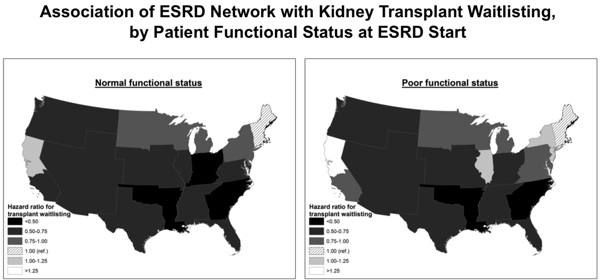Effect of Patient Functional Status on the Associations Between Kidney Transplant Waitlisting, Race, and U.S. Region
Emory University, Atlanta.
Meeting: 2015 American Transplant Congress
Abstract number: 267
Keywords: Kidney transplantation
Session Information
Session Name: Concurrent Session: Disparities in Healthcare Access
Session Type: Concurrent Session
Date: Monday, May 4, 2015
Session Time: 4:00pm-5:30pm
 Presentation Time: 5:00pm-5:12pm
Presentation Time: 5:00pm-5:12pm
Location: Room 115-C
Background: Black race and Southeastern residence at the start of end-stage renal disease (ESRD) are associated with reduced access to the U.S. kidney transplant waitlist, but whether these associations differ by patient functional status, which may also be associated with likelihood of waitlisting, is unknown.
Methods: Using United States Renal Data System data on 445,192 ESRD patients aged 18-69 initiating treatment on or after 7/1/05 (follow-up through 9/30/12), we assessed associations of race (black vs. white) and region (ESRD Network) with transplant waitlisting using Cox proportional hazards models, both overall and by patient functional status, adjusted for age, race/ethnicity, sex, employment, insurance, patient knowledge of transplant option, pre-ESRD nephrology care, cardiovascular disease, cancer, BMI, and tobacco use. Functional status was defined by provider report of difficulty with activities of daily living, inability to ambulate or transfer, or being institutionalized at ESRD start.
Results: Overall, 57,556 (12.9%) of patients had poor functional status at ESRD start; 5.0% vs. 22.1% of patients with poor vs. normal functioning were waitlisted (adjusted HR=0.37, 95% CI 0.36-0.39). Black vs. white ESRD patients were less likely to have poor functional status (11.8% vs. 15.1%). Among ESRD patients with normal functional status, blacks were 13% less likely to be waitlisted (adjusted HR=0.87, 95% CI 0.86-0.89) than whites, but the association was attenuated among those with poor functional status (adjusted HR=0.92, 95% CI 0.84-1.01; Pinteraction=0.03). The prevalence of poor functional status varied considerably by ESRD Network (9.5-15.4%). However, geographic patterns of waitlisting generally did not differ by patient functional status (Pinteraction>0.05 for most Networks; below).
Conclusion: While functional status does not appear to substantially modify the association of black race and U.S. region (particularly, the Southeast) with waitlisting, provider-reported functional status at ESRD start varies considerably by race and geography, and poor functional status is strongly associated with reduced access to the kidney transplant waitlist.
To cite this abstract in AMA style:
Plantinga L, Patzer R, Pastan S, Bowling C. Effect of Patient Functional Status on the Associations Between Kidney Transplant Waitlisting, Race, and U.S. Region [abstract]. Am J Transplant. 2015; 15 (suppl 3). https://atcmeetingabstracts.com/abstract/effect-of-patient-functional-status-on-the-associations-between-kidney-transplant-waitlisting-race-and-u-s-region/. Accessed December 18, 2025.« Back to 2015 American Transplant Congress
